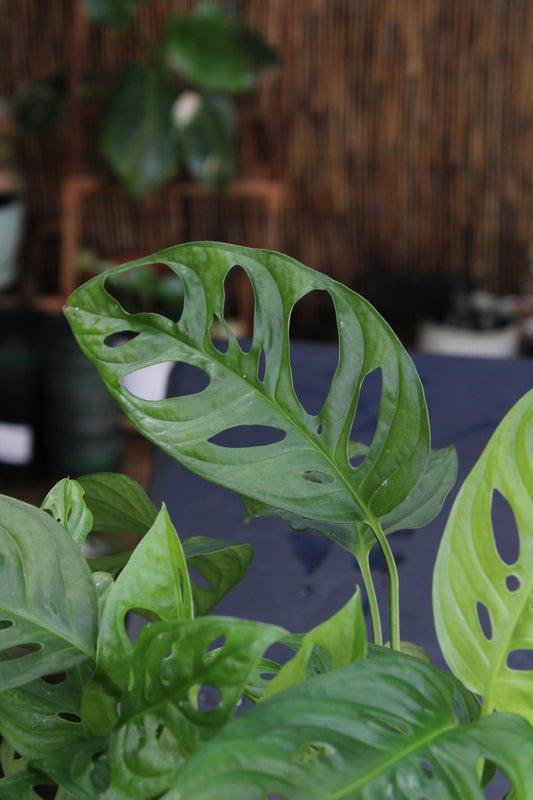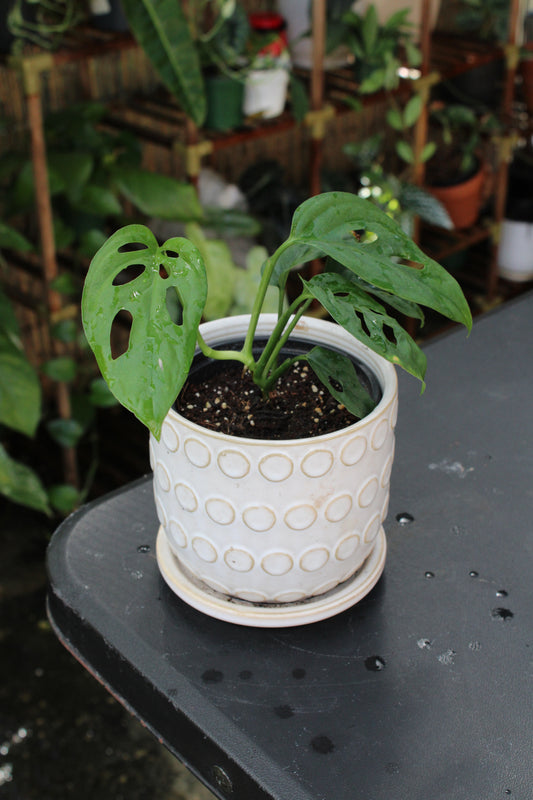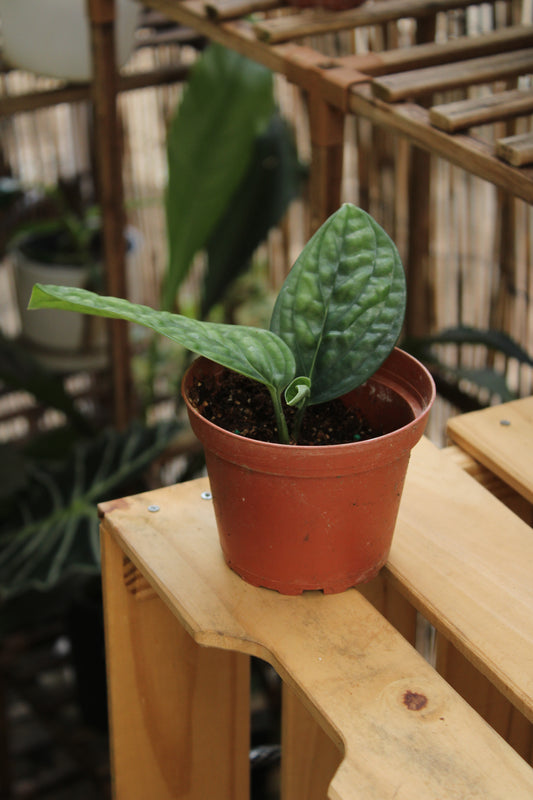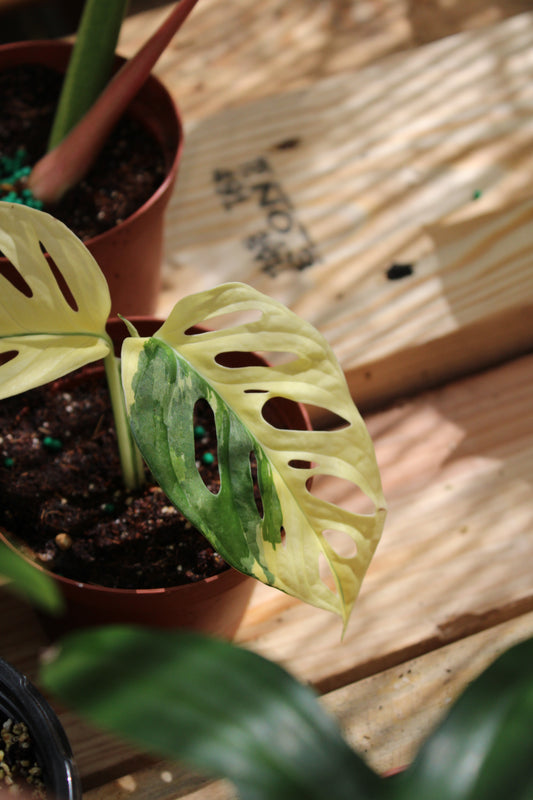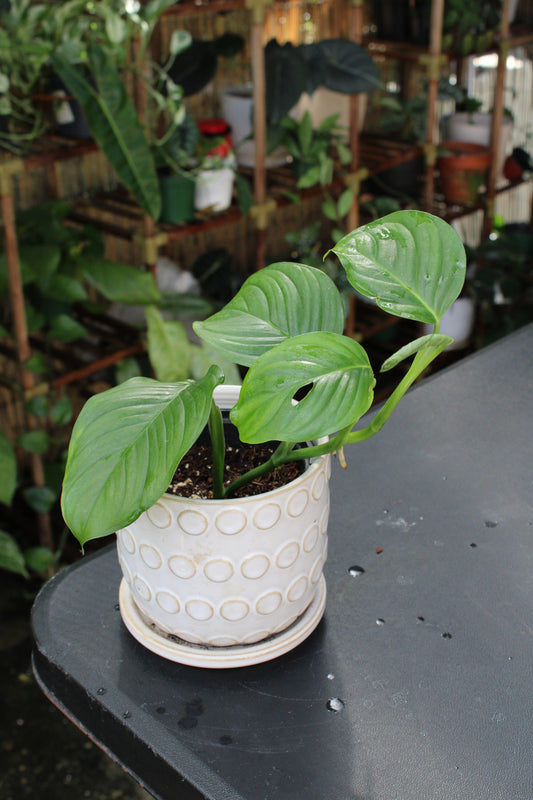
Monstera Care
Monsteras are a diverse and fascinating group of plants characterized by their unique leaves, distinctive inflorescence, and adaptability to various habitats, making them a prominent and sought-after part of the world of indoor and tropical plant.
Collapsible content

Adansonii Monstera
LIGHT
The Swiss Cheese Wide Leaf Monstera or “Adansonii” prefers bright indirect light, but will tolerate medium to low light. Too little light will slow down growth. It can’t tolerate direct sunlight will burn the leaves.
WATER
Water this monstera when it's 75% dry or when the soil is completely dry. Overwatering will cause yellow leaves and it may die.
HUMIDITY
Monsteras do well in low humidity, but as tropical plants they enjoy high humidity like 60% or more. High humidity will make the plant thrive and grow faster. It will benefit an additional misting for bigger and fenestrated leaves.
TEMPERATURE
Your Monstera prefers temperatures between 65-90 degrees.
FOOD
This monstera likes to be fed monthly or every other month with some general indoor plant fertilizer.
TOXICITY
Monsteras are toxic to pets and humans consuming this plant is highly irritating, especially to the mouth and even the stomach when ingested.
Additional Tips*
This plant will benefit from a moss support or a coconut fiber support. Any type of support that can contribute to its growth pattern will help this plant reach maturity.
When this plant reaches maturity it tends to fenestrate.
Use a well-draining substrate, such as a mixture of coconut fiber, perlite, pine bark, and activated charcoal. This ensures good aeration and prevents excess humidity.
Deliciosa Monstera
LIGHT
Monsteras prefers bright indirect light, but will tolerate medium to low light. Too little light will slow growth. It cannot tolerate direct sunlight and will burn the leaves.
WATER
Water this monstera when it is 75% dry or when the soil is completely dry. Overwatering will cause yellow leaves and may die.
HUMIDITY
Monsteras grow well in low humidity, but as tropical plants, they enjoy high humidity, such as 60% or higher. High humidity will cause the plant to thrive and grow faster. An additional mist will be beneficial for larger, fenestrated leaves.
TEMPERATURE
Your Monstera prefers temperatures between 65 and 90 degrees.
FOOD
This monstera likes to be fed monthly or every other month with a bit of general houseplant fertilizer.
TOXICITY
Monsteras are toxic to pets and humans; Consuming this plant is highly irritating, especially to the mouth and even the stomach when ingested.
Additional Tips*
This plant will benefit from a moss support or a coconut fiber support. Any type of support that can contribute to its growth pattern will help this plant reach maturity.
When this plant reaches maturity it has to fenestrate.
Use a well-draining substrate, such as a mixture of coconut fiber, perlite, pine bark, and activated charcoal. This ensures good aeration and prevents excess humidity.
Esqueleto Monstera
LIGHT
The Esqueleto monstera prefers bright indirect light, but will tolerate medium light. It can’t tolerate direct sunlight will burn the leaves.
WATER
Water this monstera when its 25% dry or when the top inches of soil are dry. Overwatering will cause yellow leaves and it may die.
HUMIDITY
It generally needs above average humidity like 60-80% but will do fine in household humidity
TEMPERATURE
Your Monstera prefers temperatures between 65-80 degrees.
FOOD
The Monstera Esqueleto likes to be fed monthly or every other month with some general indoor plant fertilizer.
TOXICITY
It's toxic to pets and humans
Additional Tips*
This plant will benefit from a moss support or a coconut fiber support. Any type of support that can contribute to its growth pattern will help this plant reach maturity.
When this plant reaches maturity it tends to fenestrate.
Use a well-draining substrate, such as a mixture of coconut fiber, perlite, pine bark, and activated charcoal. This ensures good aeration and prevents excess humidity.
Leicheriana Monstera
LIGHT
Monsteras prefers bright indirect light, but will tolerate medium to low light. Too little light will slow growth. It cannot tolerate direct sunlight and will burn the leaves.
WATER
Water this monstera when it is 75% dry or when the soil is completely dry. Overwatering will cause yellow leaves and may die.
HUMIDITY
Monsteras grow well in low humidity, but as tropical plants, they enjoy high humidity, such as 60% or higher. High humidity will cause the plant to thrive and grow faster. An additional mist will be beneficial for larger, fenestrated leaves.
TEMPERATURE
Your Monstera prefers temperatures between 65 and 90 degrees.
FOOD
This monstera likes to be fed monthly or every other month with a bit of general houseplant fertilizer.
TOXICITY
Monsteras are toxic to pets and humans; Consuming this plant is highly irritating, especially to the mouth and even the stomach when ingested.
Additional Tips*
This plant will benefit from a moss support or a coconut fiber support. Any type of support that can contribute to its growth pattern will help this plant reach maturity.
When this plant reaches maturity it has to fenestrate.
Use a well-draining substrate, such as a mixture of coconut fiber, perlite, pine bark, and activated charcoal. This ensures good aeration and prevents excess humidity.
Perú Monstera
LIGHT
Monsteras prefers bright indirect light, but will tolerate medium to low light. Too little light will slow growth. It cannot tolerate direct sunlight and will burn the leaves.
WATER
Water this monstera when it is 75% dry or when the soil is completely dry. Overwatering will cause yellow leaves and may die.
HUMIDITY
Monsteras grow well in low humidity, but as tropical plants, they enjoy high humidity, such as 60% or higher. High humidity will cause the plant to thrive and grow faster. An additional mist will be beneficial for larger, fenestrated leaves.
TEMPERATURE
Your Monstera prefers temperatures between 65 and 90 degrees.
FOOD
This monstera likes to be fed monthly or every other month with a bit of general houseplant fertilizer.
TOXICITY
Monsteras are toxic to pets and humans; Consuming this plant is highly irritating, especially to the mouth and even the stomach when ingested.
Additional Tips*
This plant will benefit from a moss support or a coconut fiber support. Any type of support that can contribute to its growth pattern will help this plant reach maturity.
When this plant reaches maturity it has to fenestrate.
Use a well-draining substrate, such as a mixture of coconut fiber, perlite, pine bark, and activated charcoal. This ensures good aeration and prevents excess humidity.
Variegated Adansonii Monstera
LIGHT
The Variegated Adansonii Monstera prefers bright indirect light, but will tolerate medium to low light. Too little light will reduce variegation. It can’t tolerate direct sunlight will burn the leaves.
WATER
Water this monstera when it's 75% dry or when the soil is completely dry. Overwatering will cause yellow leaves and it may die.
HUMIDITY
Monsteras do well in low humidity, but as tropical plants they enjoy high humidity like 60% or more. High humidity will make the plant thrive and grow faster. It will benefit an additional misting for bigger and fenestrated leaves.
TEMPERATURE
Your Monstera prefers temperatures between 65-90 degrees.
FOOD
This monstera likes to be fed monthly or every other month with some general indoor plant fertilizer.
TOXICITY
Monsteras are toxic to pets and humans consuming this plant is highly irritating, especially to the mouth and even the stomach when ingested.
Additional Tips*
This plant will benefit from a moss support or a coconut fiber support. Any type of support that can contribute to its growth pattern will help this plant reach maturity.
When this plant reaches maturity it tends to fenestrate.
Use a well-draining substrate, such as a mixture of coconut fiber, perlite, pine bark, and activated charcoal. This ensures good aeration and prevents excess humidity.
Variegated Statleyana Monstera
LIGHT
The Variegated Statleyana Monstera prefers bright indirect light, but will tolerate medium to low light. Too little light will reduce variegation. It can’t tolerate direct sunlight will burn the leaves.
WATER
Water this monstera when it's 75% dry or when the soil is completely dry. Overwatering will cause yellow leaves and it may die.
HUMIDITY
Monsteras do well in low humidity, but as tropical plants they enjoy high humidity like 60% or more. High humidity will make the plant thrive and grow faster. It will benefit an additional misting for bigger and fenestrated leaves.
TEMPERATURE
Your Monstera prefers temperatures between 65-90 degrees.
FOOD
This monstera likes to be fed monthly or every other month with some general indoor plant fertilizer.
TOXICITY
Monsteras are toxic to pets and humans consuming this plant is highly irritating, especially to the mouth and even the stomach when ingested.
Additional Tips*
This plant will benefit from a moss support or a coconut fiber support. Any type of support that can contribute to its growth pattern will help this plant reach maturity.
Use a well-draining substrate, such as a mixture of coconut fiber, perlite, pine bark, and activated charcoal. This ensures good aeration and prevents excess humidity.


